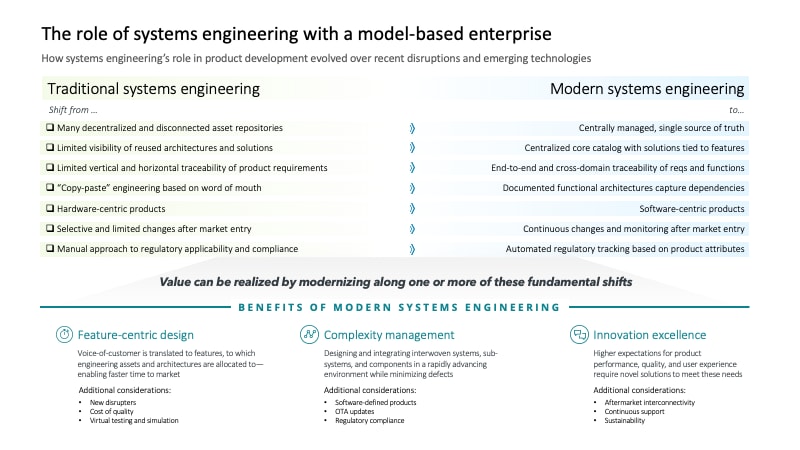MBSE for a Model-Based Enterprise | Deloitte US has been saved
The rise of model-based systems engineering
Increasingly manufacturers in the automotive, aerospace, and defense industries (among others) are pursuing MBSE to not just streamline product development and reduce time to market, but also refresh product features. This new approach employs a digital backbone to create models that enable interconnectivity throughout the product development life cycle, not during initial production only. That new software update for your car? That’s MBSE in action. The inherent advantages of MBSE demonstrate the value of evolving from traditional systems engineering to a modern, model-based approach.
Automotive, aerospace, and defense manufacturers alike have begun to take more control of their product functionality and reduce the number of suppliers and product controllers. With chips becoming much more powerful, fewer are required. Separating the logic behind the product and its software can enable plug-and-play and hardware-agnostic software. Each time a manufacturer wants to introduce extra features or capabilities, it can now design those in the software with MBSE, then push product updates. Imagine the savings if a field issue is found. The change happens in the software model, eliminating the need for a hardware recall.
This process is similar to smartphone development. The software is separate from the phone itself and is refreshed periodically, minimizing required changes to the phone hardware. This approach can enable auto manufacturers, for example, to introduce new features or fixes more often.
What exactly is MBSE, and why is it becoming an essential tool for engineers across industries? In this blog entry, we’ll explore the potential benefits of MBSE, from enabling a model-based enterprise to enhancing collaboration between hardware and software teams. MBSE helps solve common issues of complex systems by enabling end-to-end traceability between design features and their corresponding requirements.
Forces driving the shift to MBSE
Several factors are propelling the transition toward MBSE:
- Increased pervasiveness of software in product design is the most notable factor. Historically, software was developed as the product neared production, which could result in time-consuming bottlenecks. In the automotive industry, manufacturers are shifting to the software-defined vehicle to reduce costs and enhance features and time to market. MBSE allows software design to be moved forward, allowing better integration for software into the product design.
- Increased development speed is promoted by MBSE through concurrent development. It links data flows and visualizes system interactions in product design. Digital system modeling manages features throughout the product life cycle and outlines the progression of hardware and software decisions. By fully defining a system model with upfront flexibility, rework is reduced later in the development process, which can accelerate the time to market.
- Industry forces have also played a role in the shift to MBSE. For example, the US government is requiring aerospace and defense contractors to utilize MBSE. MBSE allows the US government to perform design reviews early and often—streamlining key design decisions around speed and affordability. Without MBSE, costly changes may arise later in the development life cycle. MBSE offers traceability throughout the product development life cycle, which facilitates verification and validation against product requirements. This traceability again can help minimize the need for extensive rework later.
Challenges facing MBSE adoption
In the past, the application of model-based systems engineering was limited across enterprises due to the primary focus of manufacturers on product hardware. Engineers proficient in utilizing a model-based systems approach were rare—and even when present, their integration within the product hardware process wasn’t seamless. There are further key challenges facing adoption:
- Skills shortage: The expertise required for this specialized area contributes to a skills shortage. As the training for this field demands years, the overall maturity level of the MBSE approach remains low in the current scenario.
- Complexity of tools: The maturity of MBSE is further hampered by the evolution of the tools involved. Most tools working with systems modeling language are extremely complex at present, necessitating more comprehensive integration with other backbone technologies in the overall digital thread.
- Resistance to change: There persists a reluctance to change traditional ways of working. Engineering teams usually operate within specific product-related silos, neglecting features that could be universally applied across products. For instance, leading handheld manufacturers might have separate teams for phones, tablets, and laptops—despite the shared features of components (such as screens) among these products.
The introduction of the MBSE approach signifies a transition toward a model-based enterprise. This approach designs features and determines how software will function across product hardware platforms, rather than being exclusive to a single product. Consequently, the need for isolated teams is reduced, encouraging integrated thinking. Here’s a glimpse into the new paradigm:
Click image to enlarge
The value of a model-based enterprise approach
Manufacturers today are under pressure to reduce product costs and development times as their products become increasingly complex. To respond to this challenge, they are freeing themselves from legacy thinking, processes, and systems to shift their organizations to a model-based enterprise. Research indicates more than 85% of organizations across industries are pursuing initiatives to bolster model-based enterprise capabilities.1
- Manage complexity and reduce defects: MBSE is part of this model-based enterprise approach and although originally seen as a competency area, it’s becoming more of an operational domain. This is because the standardized systems modeling language used with MBSE supports analysis, design, verification, and validation for various types of systems. Manufacturers can model manufacturing and test for glitches in the process before the product hits the manufacturing floor. Complexity management and defects diminish.
For example, if features in the software are changed to add more capabilities, a more advanced robot may be needed in manufacturing. With MBSE, manufacturers can simulate this scenario to discover how processes must be modified. The downstream or upstream effects of changes become readily apparent. This enables organizations to achieve significant gains in engineering productivity, defect reduction, and manufacturing and service excellence. - Improve labor efficiency and boost innovation excellence: Instead of siloed teams working on specific components of a product—such as the interior, engine, and display of a car—integrated cross-functional teams are established, eliminating boundaries. This can enable teams to complete designs faster and be interconnected in a new way. When changes are made to the car’s features, they can reuse preexisting work in new applications. Products that have common elements and pieces can be developed much faster and more efficiently. Innovation excellence can skyrocket.
To realize these benefits, organizations must shift their thinking from product by product to platforms.
Embarking on the model-based enterprise journey
As manufacturers progress toward a model-based enterprise, results will likely depend on the organization’s ability to centralize its business around singular, model-based sources of truth—starting with MBSE. MBSE can be particularly well-suited for organizations that need to accomplish multiple objectives (such as functionality, safety, and cost ) simultaneously. This allows feature-centric designs based on the voice of the customer to come to fruition faster.
Developing a system model framework, established to proper standards, and paired with infrastructure and an overall model-based enterprise integration strategy will allow manufacturers to collaborate more effectively. This will likely lead to more efficient configuration and quality management, product and service innovation, and other improved enterprise functions .
Organizations can start by bringing multiple functions together, identifying bottlenecks, assessing the current state, defining future-state needs, and addressing concerns and next steps.
Want to learn more? Let’s connect.
 | Stavros Stefanis |
Endnotes:
1 Deloitte, “A model-based enterprise: The full value of MBE capabilities,” April 27, 2022.


